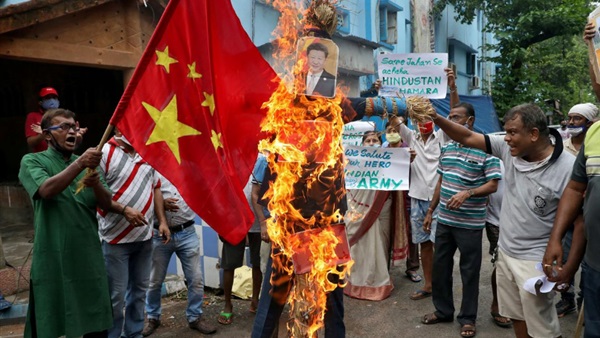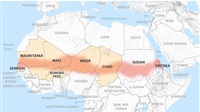Indian soldiers unarmed and caught by surprise in China clash, families say

Indian soldiers who died in close combat with
Chinese troops last month were unarmed and surrounded by a larger force on a
steep ridge, Indian government sources, two soldiers deployed in the area and
families of the fallen men said.
One of the Indian soldiers had his throat slit with
metal nails in the darkness, his father told Reuters, saying he had been told
by a fellow soldier who was there.
Others fell to their deaths in the freezing waters
of the Galwan river in the western Himalayas, relatives have learned from
witnesses.
Twenty Indian soldiers died in the June 15 clash on
the de facto border separating the two armies. The soldiers all belonged to the
16th Bihar Regiment deployed in the Galwan region.
No shots were fired, but it was the biggest loss of
life in combat between the nuclear-armed neighbours since 1967, when the
simmering border dispute flared into deadly battles.
Reuters spoke to relatives of 13 of the men who were
killed, and in five cases they produced death certificates listing horrific
injuries suffered during the six-hour night-time clash at 14,000 ft (4,267
metres) amid remote, barren mountains.
Reuters contacted the military hospital in India’s
Ladakh region where the bodies were brought. The hospital declined to comment
on the cause of death and said that the bodies were sent to the families along
with the death certificates.
Reuters also spoke to two soldiers of the Bihar
Regiment deployed in the area, who were among those who accompanied the bodies
of fallen colleagues to their homes in the area. They were not directly
involved in the melee.
The soldiers cannot be named because of military
rules and all the families asked for anonymity because they said they were not
supposed to speak about military matters.
The Indian defence ministry did not respond to a
request for comment on the fighting on June 15.
In response to a Reuters query, a China foreign
ministry spokesperson repeated previous statements blaming the Indian side for
crossing the de facto border and provoking the Chinese.
“When Chinese officers and soldiers went there to
negotiate, they were suddenly and violently attacked by the Indian troops,” the
spokesperson said. “The rights and wrongs of the incident are very clear. The
responsibility absolutely does not lie with the Chinese.”
China has not provided evidence of Indian
aggression. China’s defence ministry did not respond to a request for comment.
Three of the dead men had their “arteries ruptured
in the neck” and two sustained head injuries caused by “sharp or pointed
objects”, the death certificates seen by Reuters said.
There were visible marks on the neck and forehead,
all five documents said.
“It was a free-for-all, they fought with whatever
they could lay their hands on - rods, sticks, and even with their bare hands,”
said a government official in Delhi briefed on the clash.
The Indian government has said that the People’s
Liberation Army (PLA) acted in a premeditated manner, but it has not provided a
full account of the clash that stunned the country and stoked popular anger
against China.
China has dismissed an Indian government minister’s
claim that China had lost 40 soldiers from the PLA’s western theatre command
deployed in Galwan.
Its envoy to Delhi suggested in remarks to local
media and posted on the embassy website that there had been losses on both
sides.
“The Indian army suddenly and violently attacked the
Chinese officers and soldiers who went for negotiation, causing fierce physical
conflicts and casualties between the two sides,” Sun Weidong said.
Indian government officials have told Reuters that
the conflict began when the commanding officer of the Bihar regiment led a
small party to Patrol Point 14 to verify whether the Chinese had made good
their promise to withdraw from the disputed site and dismantle structures they
had built there.
In recent weeks the world’s two most populous
countries have mobilised more forces along the 3,488 km Line of Actual Control
(LAC), and the renewed hostilities have triggered a diplomatic and commercial
spat that threatens to escalate, experts including former Indian military
officers say.
The possibility that unarmed Indian soldiers were
overrun by a larger force could further fuel resentment against China and raise
questions about why Indian soldiers were sent to a tense frontline without
being armed.
“How dare China kill our unarmed soldiers. Why were
our soldiers sent unarmed to martyrdom?” Rahul Gandhi, leader of the main
opposition Congress party wrote in a tweet, demanding the government provide a
full account.
A relative of one of the soldiers who accompanied
Colonel Santosh Babu, the commanding officer, to the site of two tents erected
by the Chinese troops told Reuters that members of the Indian patrol were
unarmed.
They were confronted by a small group of Chinese
soldiers and an argument ensued over the tents and a small observation tower
the relative said, on the basis of conversations with two other soldiers who
were present.
Reuters was unable to establish all of the details
of what happened, but government officials in New Delhi briefed on the incident
said that at some point Indian troops took down the observation post and the
tents because they were on India’s side of the LAC.
Soon after the Indian side came under attack from a
large Chinese force that pelted them with stones and attacked them with
sharp-edged weapons, according to the families of three dead Indian soldiers,
based on conversations they had with survivors.
Some soldiers retreated to safety on the ridgeline
in the darkness, but when they could not find the commanding officer, they
re-emerged and came under fresh attack, four family members said.
Babu was among those killed in the fighting, the
Indian government said. One of the soldiers deployed in the area that Reuters
spoke to said the Indian patrol was outnumbered by the PLA.
“The Chinese side overwhelmed our people by sheer
numbers,” said the soldier, who overheard radio messages seeking reinforcements
being sent to regional headquarters in Ladakh.
Three of the Indian families said they had been told
by soldiers who were commissioned to bring the bodies back to them that some
combatants pushed each other into the fast-flowing Galwan river.
The government official in Delhi also said bodies of
some soldiers were fished out of the river the next morning. Some had succumbed
to hypothermia, the official added.
Additional reporting by Yew Lun Tian and Tony Munroe
in Beijing, Fayaz Bukhari in Srinagar, Subrata NagChoudhury in Kolkata,
Jatindra Dash in Bhubaneswar, Saurabh Sharma in Lucknow; Editing by Mike
Collett-White







